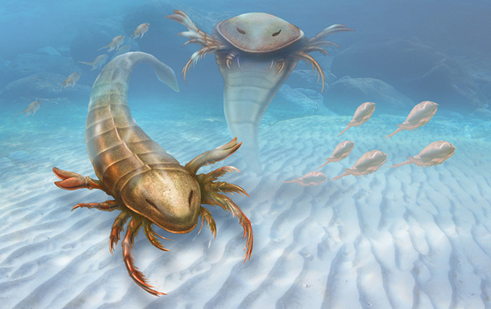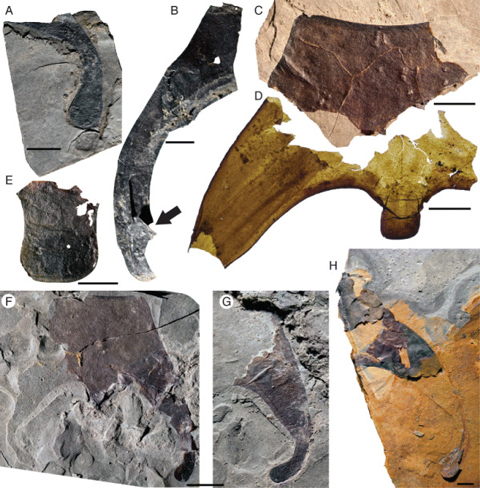The Oldest Known Eurypterid
Not Jaws but Claws Pentecopterus decorahensis
Named after an ancient Greek ship (penteconter) which was renowned for its speed and agility, a new and somewhat surprising addition to the mega-fauna of the Middle Ordovician has been described in a paper published in the academic journal “BMC Evolutionary Biology – Bio Med Centre”. Enter Pentecopterus decorahensis (pent-tee-kop-ter-rus dek-kor-rah-en-sis), which at around 1.7 metres in length suggests that this was an apex predator of the brackish, shallow marine environment represented by shale deposits located in north-east Iowa (United States).
A Very Fearsome Arthropod – P. decorahensis
Picture credit: Patrick Lynch/Yale University
Pentecopterus decorahensis
This armour-plated, marine predator is a member of the Order Eurypterida, an extinct group of arthropods distantly related to spiders and lobsters. These creatures are often referred to as sea scorpions as they are distantly related to modern-day scorpions too. With its streamlined body, grasping limbs for trapping prey and large, well-protected head this formidable carnivore would have dined on a variety of invertebrates as well as jawless fishes.
Winneshiek Lagerstätte
The fossils are part of the extraordinary Winneshiek Lagerstätte fauna (Iowa) and have been dated to around 467 million years ago (Darriwilian faunal stage of the Middle Ordovician). Something in excess of 250 different eurypterid species have been described, but only eleven species have been documented from the Ordovician (488-443 million years ago) to date. P. decorahensis is the oldest known, extending the documented range of the eurypterids by more than nine million years.
Commenting on the fossils, James Lamsdell of Yale University and the lead author of the study stated:
“This shows that eurypterids evolved some ten million years earlier than we thought and the relationship of the new animal to other eurypterids shows that they must have been very diverse during this early time of their evolution, even though they are very rare in the fossil record.”
Some of the Fossil Specimens that have been Found
Picture credit: Lamsdell et al
Highly Fossiliferous Strata
The highly fossiliferous strata was discovered by an Iowa Geological Survey team (University of Iowa), close to the Upper Iowa River. A temporary dam had to be constructed to allow the fossil site to be excavated. More than 150 fossils of Pentecopterus have been found, many of them representing juveniles.
University of Yale palaeontologist Derek Briggs, a co-author of the study explained that the shale deposits represent an ecosystem that became established when the sea flooded a meteorite impact crater some three miles across. The weak currents coupled with the oxygen depleted bottom contributed to the remarkable state of preservation of the fossil material. Even tiny hairs on the limbs can still be seen.
An Enormous Arthropod (Pentecopterus decorahensis)
Although, enormous for an arthropod, it is not the biggest eurypterid known, Everything Dinosaur has reported on a number of very large fossil sea scorpions
To read more about giant eurypterids: Giant Eurypterid Tracks Discovered in Scotland.
Giant Devonian Sea Scorpion: Claws! of the Devonian.
The largest living member of this Phylum today is the Japanese spider crab (Macrocheira kaempferi), the diameter of the legs of the largest males can be in excess of 3.5 metres and some specimens have weighed more than fifteen kilogrammes.
Everything Dinosaur Comments
A spokesperson from Everything Dinosaur stated:
“Thanks to the remarkable Winneshiek Lagerstätte scientists have been able to look into a window of marine life from some 467 million years ago. Anyone taking a dip in the brackish waters that linked this part of Iowa to the seas surrounding the ancient land mass of Laurentia had better watch out. This was one arthropod capable of giving you more than just a “nip” with its claws.”
CollectA have created a range of replicas that represent significant ancient invertebrates from the fossil record: Replicas of Iconic Fossil Invertebrates (CollectA).



